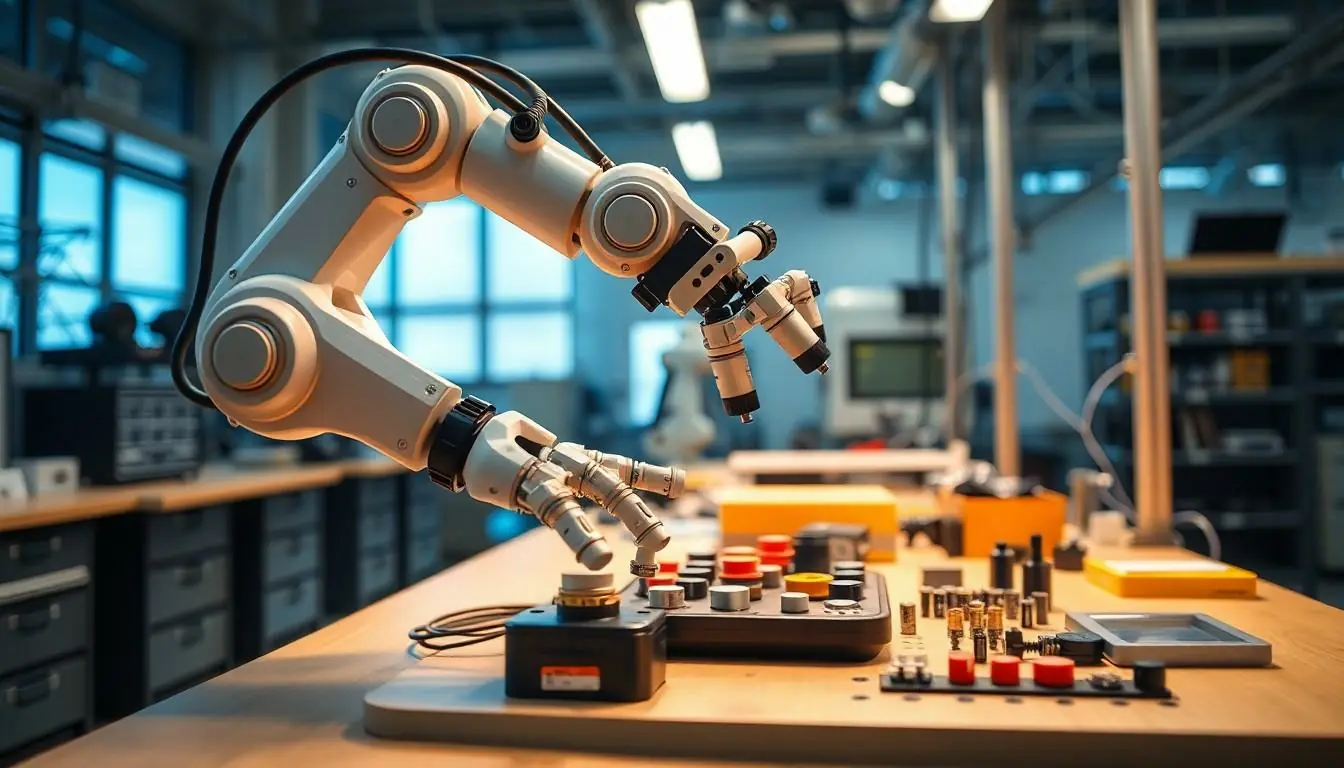Table of Contents
ToggleIn a world where robots might soon be more common than coffee machines, engineering robotics is taking center stage. Imagine a future where your morning coffee is brewed by a friendly robot while you enjoy a leisurely breakfast—sounds like a sci-fi movie, right? But it’s happening now, and engineers are at the helm, crafting the future one circuit at a time.
From autonomous vehicles to surgical assistants, the scope of robotics is as vast as a toddler’s imagination. With every new innovation, engineers are breaking boundaries and proving that robots aren’t just for Hollywood anymore. They’re here to revolutionize industries, improve lives, and maybe even help you find your misplaced keys. Buckle up, because engineering robotics is not just a field; it’s a thrilling ride into the future.
Overview of Engineering Robotics
Engineering robotics encompasses the design, development, and application of robots across various fields. Robotics engineers innovate by creating systems that perform tasks traditionally done by humans. The versatility of robotics manifests in numerous industries, including manufacturing, healthcare, and transportation.
Autonomous vehicles exemplify robotics’ impact on daily life. Engineers develop complex algorithms that enable these vehicles to navigate and make real-time decisions. Surgical robots represent another significant advancement, assisting medical professionals with precision and accuracy during procedures.
Additionally, manufacturing robots increase efficiency and productivity on assembly lines. Many factories utilize robotic arms to handle repetitive tasks, freeing human workers to focus on complex duties. Efficient robotic systems streamline processes and reduce errors, benefiting industries economically.
In agriculture, drones assist in monitoring crop health and optimizing resource use. Through engineering, these robots gather data quickly and efficiently, enabling better decision-making for farmers. Environmental monitoring also benefits, with robots collecting data from remote or hazardous areas.
Overall, engineering robotics transforms various sectors by enhancing productivity and safety. Engineers push boundaries, exploring new materials and technologies to advance robotics further. With ongoing research and development, many envision solutions that integrate robotics seamlessly into everyday life.
Key Components of Engineering Robotics

Engineering robotics relies on several key components that enable functionality and efficiency. Sensors and actuators form the backbone of robotic systems by allowing interaction with the environment.
Sensors and Actuators
Sensors detect environmental conditions, enabling robots to respond appropriately. They measure variables like temperature, pressure, and distance. Common types of sensors include infrared, ultrasonic, and cameras, which gather essential data for decision-making. Actuators, on the other hand, are responsible for movement and control. They convert energy into motion, using electric motors or hydraulic systems to perform tasks like gripping or navigating. Together, sensors and actuators facilitate dynamic responses, ensuring robots adapt effectively to varying situations.
Control Systems
Control systems integrate the inputs from sensors to manage the actions of actuators in real-time. Feedback loops play a crucial role, allowing constant adjustment based on sensor data. Programmable logic controllers (PLCs) and microcontrollers serve as the brain of robotic systems, making rapid calculations and executing commands. Engineers design algorithms to enhance control strategies, improving precision and response time. These systems ensure robots operate smoothly and effectively, leading to improved performance in applications such as manufacturing and healthcare.
Applications of Engineering Robotics
Engineering robotics plays a pivotal role across various sectors. Its applications demonstrate how technology maximizes efficiency and innovation.
Industrial Automation
Robots significantly enhance industrial automation by streamlining production processes. These machines perform repetitive tasks with precision, reducing human error. Factories often employ robotic arms for assembling components, painting, and welding. With the integration of artificial intelligence, machines continuously adapt to new tasks and optimize workflow. The use of robots leads to increased output and reduced operational costs, reinforcing their importance in manufacturing.
Medical Robotics
Robotics transforms medical practices by providing advanced surgical assistance. Surgeons utilize robotic systems for intricate procedures, allowing for minimally invasive techniques. Enhanced precision leads to shorter recovery times and improved patient outcomes. Additionally, robots assist in rehabilitation, enabling tailored therapy programs that adapt to individual needs. With ongoing advancements, medical robotics stands at the forefront of patient care and surgical innovations.
Educational Robotics
Robotics enriches educational environments by engaging students in STEM learning. Schools and institutions incorporate robots to teach coding, engineering, and problem-solving skills. Projects often involve teamwork and creativity, enhancing collaboration among students. Various kits and platforms allow learners to design and program their own robots, fostering interest in technology. Educational robotics not only aids skill development but also prepares students for future careers in engineering and technology fields.
Future Trends in Engineering Robotics
Engineering robotics is evolving rapidly, with new trends shaping the future landscape. Innovations are making robots more intelligent and capable of working alongside humans.
Artificial Intelligence Integration
Artificial intelligence is transforming engineering robotics, bringing advanced learning capabilities to machines. Systems equipped with AI can analyze data, recognize patterns, and make decisions in real time. Such enhancements allow robots to perform complex tasks, like adjusting to dynamic environments autonomously. Increased machine learning capabilities enable robots to improve from experiences, adapting their functions for greater efficiency. Current applications show AI-driven robots in fields such as healthcare, where they assist in diagnostic procedures, and manufacturing, where they predict maintenance needs. Significant improvements in operational efficiency are evident as this technology continues to develop.
Collaborative Robots (Cobots)
Collaborative robots, or cobots, revolutionize how humans interact with robotic systems. Designed to work safely alongside people, these robots enhance productivity in various settings. Cobots excel in tasks requiring fine motor skills and precision, effectively supporting human workers. Increased flexibility allows them to adapt to different work environments without extensive programming. Manufacturers in industries ranging from assembly to logistics benefit from cobots by streamlining operations and reducing manual labor. High demand for this technology continues as companies seek to optimize workflows and create safer workspaces.
Challenges in Engineering Robotics
Engineering robotics faces several challenges, including safety concerns and technical limitations. These issues hinder progress in realizing the full potential of innovative robotic systems.
Safety Concerns
Safety remains a top priority in engineering robotics. Robots operating in shared environments with humans create risks of accidents and injuries. Ensuring safety requires robust design and testing protocols. For instance, standards like ISO 10218 guide manufacturers in creating safe robotic systems. Adopting these standards minimizes hazards. Furthermore, incorporating safety features such as emergency stop buttons and collision detection systems enhances user protection. Engineers must prioritize these features to build trust with end-users and promote wider adoption of robotics across industries.
Technical Limitations
Technical limitations also pose significant challenges in robotics. Many robots still struggle with complex tasks requiring advanced decision-making. Enhancements in artificial intelligence are crucial to overcoming these limitations. Current algorithms may lack the ability to process vast amounts of data quickly or adapt to changing environments seamlessly. For example, navigation in dynamic settings can lead to errors in autonomous vehicles. Improving sensor accuracy remains vital for tasks such as object recognition and movement. Engineers must innovate continuously to develop more sophisticated systems capable of addressing these inherent limitations effectively.
Engineering robotics is reshaping the landscape of various industries and everyday life. As technology advances, the integration of robotics into sectors like healthcare, manufacturing, and agriculture becomes increasingly seamless. This evolution not only enhances efficiency but also fosters innovation and safety.
The future holds immense potential as engineers continue to push boundaries, developing smarter and more adaptable robotic systems. With ongoing research and development, the journey into robotics promises to unveil even more transformative applications. Embracing these advancements will be crucial for individuals and organizations looking to thrive in an ever-evolving technological world. The excitement surrounding engineering robotics signals a bright future filled with possibilities.




